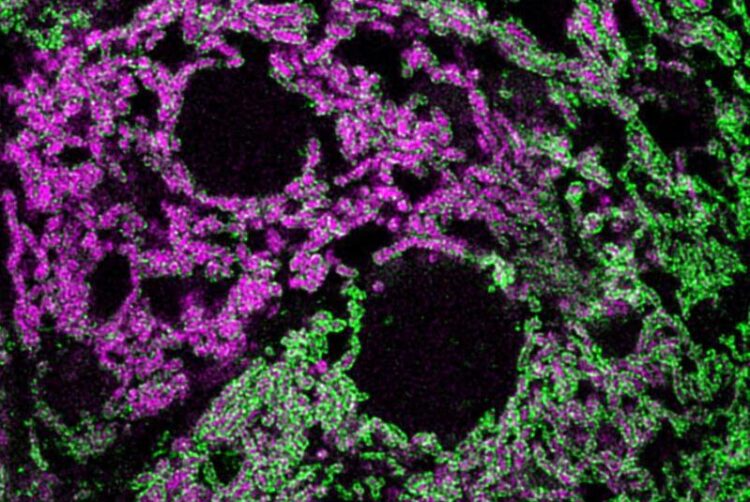Targeting gene expression in mitochondria

The image shows mouse hepatocytes where the process of mitochondrial translation is visualized (magenta) within the mitochondrial matrix enclosed by the mitochondrial membrane (green).
Source: R. Yousefi, Department of Cellular Biochemistry, UMG
Göttingen Scientists of the Cluster of Excellence Multiscale Bioimaging (MBExC) and the Collaborative Research Center 1190 develop novel strategy to investigate gene expression in mitochondria. Published in “Cell”.
Mitochondria are considered the power plants of cells because they generate energy from our food with the help of oxygen. The machinery required for this is called the respiratory chain. Its central building blocks are formed by mitochondria themselves through the expression of genes of their own genetic material. Malfunctions in gene expression can cause an imbalance of energy production thus leading to severe and often fatal diseases of the nervous and cardiac system. Mechanisms of gene expression in mitochondria are still poorly understood.
A team of scientists led by Prof. Dr. Peter Rehling, Director of the Institute of Cellular Biochemistry at the University Medical Center Göttingen (UMG), speaker of the Collaborative Research Center SFB1190, and member of the Göttingen Cluster of Excellence “Multiscale Bioimaging: From Molecular Machines to Networks of Excitable Cells” (MBExC) are now one step further. They have developed a completely new strategy that, for the first time, enables to experimentally alter protein formation in mitochondria. The knowledge thus gained also allows conclusions to be drawn about the development of “mitochondrial diseases”. The technique was recently published in the renowned journal “Cell”.
Original publication: An in vitro system to silence mitochondrial gene expression. Cruz-Zaragoza LD, Dennerlein S, Linden A,Yousefi R, Lavdovskaia E, Aich A Falk RR, Gomkale R, Schöndorf T, Bohnsack MT, Richter-Dennerlein R, Urlaub H, Rehling P (2021) Cell, 184, 1-14. doi: 10.16/j.cell.2021.09.033.
Research results in detail
In the process of mitochondrial gene expression, multiple factors regulate the formation of proteins (translation) for the respiratory chain. Disturbances in this process are associated with a variety of diseases, including cardiovascular disease and nervous system disorders. “In order to develop approaches to prevent disease-relevant disorders, we must first understand the molecular mechanisms of gene expression in mitochondria. Therefore, reductionist approaches are indispensable tools”, says Prof. Rehling, senior author of the study. “They allow us to dissect biological processes at different levels and in this way study the function of individual components involved.”
Such experimental strategies have been lacking until now. A major obstacle to their development lies in the fact that mitochondria are not readily genetically accessible. To solve this problem, the scientists have developed a completely new strategy that enables them to specifically modify translation in purified mitochondria. By using minute amounts of a modified mitochondrial precursor protein, which they efficiently introduce into purified human mitochondria, they are now able to prevent the formation of individual proteins in the mitochondria.
“This in vitro system now allows us to study how the loss of expression of a single mRNA affects the physiology and organization of mitochondria, with minimal indirect impact on other processes,” says Dr. Luis Daniel Cruz-Zaragoza, scientist at the Department of Cellular Biochemistry, UMG, and first author of the study. Moreover, the scientists were able to easily transfer the technique to purified mitochondria from mice, indicating that it is also applicable in the context of studying disease models. This new experimental strategy is thus also relevant for clinical research, since disorders in mitochondrial gene expression can result in severe diseases of the nervous system and heart, which are often fatal.
The Göttingen Cluster of Excellence Multiscale Bioimaging: From Molecular Machines to Networks of Excitable Cells (MBExC) is funded since January 2019 in the framework of the Excellence Strategy of the German Federal and State Gov-ernments. Applying a unique and multiscale approach, MBExC investigates the disease-relevant functional units of electrically active cells of heart and brain, from the molecular to the organ level. The MBExC unites numerous partners from the university and extra-university institutions in Göttingen. The overall goal: to under-stand the relationship between heart and brain diseases, to link basic and clinical research, and thus to develop new therapeutic and diagnostic approaches with social implications.
Further Information
about Rehling Lab: https://biochemie.uni-goettingen.de
about MBExC: https://mbexc.de/
Wissenschaftliche Ansprechpartner:
University Medical Center Göttingen, Georg-August-University
Department of Cellular Biochemistry
Prof. Dr. Peter Rehling
Humboldtallee 23, D-37073 Göttingen
Phone +49 (0) 551 / 39-5947
E-Mail: peter.rehling@medizin.uni-goettingen.de
Cluster of Excellence Multiscale Bioimaging (MBExC)
Dr. Heike Conrad (Contact – Press Release)
Phone 0551 39-61305
E-Mail: heike.conrad@med.uni-goettingen.de
Originalpublikation:
Original publication: An in vitro system to silence mitochondrial gene expression. Cruz-Zaragoza LD, Dennerlein S, Linden A,Yousefi R, Lavdovskaia E, Aich A Falk RR, Gomkale R, Schöndorf T, Bohnsack MT, Richter-Dennerlein R, Urlaub H, Rehling P (2021) Cell, 184, 1-14. doi: 10.16/j.cell.2021.09.033.
Media Contact
All latest news from the category: Life Sciences and Chemistry
Articles and reports from the Life Sciences and chemistry area deal with applied and basic research into modern biology, chemistry and human medicine.
Valuable information can be found on a range of life sciences fields including bacteriology, biochemistry, bionics, bioinformatics, biophysics, biotechnology, genetics, geobotany, human biology, marine biology, microbiology, molecular biology, cellular biology, zoology, bioinorganic chemistry, microchemistry and environmental chemistry.
Newest articles

Superradiant atoms could push the boundaries of how precisely time can be measured
Superradiant atoms can help us measure time more precisely than ever. In a new study, researchers from the University of Copenhagen present a new method for measuring the time interval,…

Ion thermoelectric conversion devices for near room temperature
The electrode sheet of the thermoelectric device consists of ionic hydrogel, which is sandwiched between the electrodes to form, and the Prussian blue on the electrode undergoes a redox reaction…

Zap Energy achieves 37-million-degree temperatures in a compact device
New publication reports record electron temperatures for a small-scale, sheared-flow-stabilized Z-pinch fusion device. In the nine decades since humans first produced fusion reactions, only a few fusion technologies have demonstrated…





















